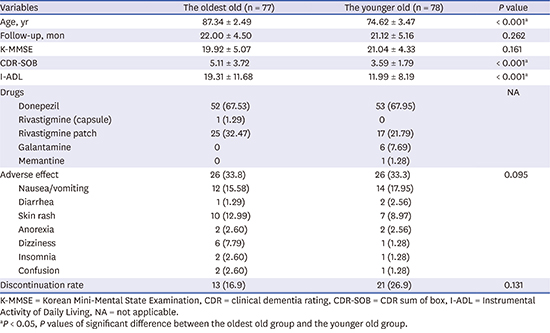1. Jorm AF, Jolley D. The incidence of dementia A meta-analysis. Neurology. 1998; 51(3):728–733.
2. Corrada MM, Brookmeyer R, Berlau D, Paganini-Hill A, Kawas CH. Prevalence of dementia after age 90 Results from The 90+ Study. Neurology. 2008; 71(5):337–343.

3. Heeren TJ, Lagaay AM, Hijmans W, Rooymans HG. Prevalence of dementia in the ‘oldest old’of a Dutch community. J Am Geriatr Soc. 1991; 39(8):755–759.
4. Ebly E, Parhad I, Hogan D, Fung T. Prevalence and types of dementia in the very old Results from the Canadian Study of Health and Aging. Neurology. 1994; 44(9):1593.

5. Schoenmaker N, Van Gool WA. The age gap between patients in clinical studies and in the general population: a pitfall for dementia research. Lancet Neurol. 2004; 3(10):627–630.

6. Leinonen A, Koponen M, Hartikainen S. Systematic Review: Representativeness of Participants in RCTs of Acetylcholinesterase Inhibitors. PLoS One. 2015; 10(5):e0124500.

7. Chen LW. Age, neuropathology, and dementia. N Engl J Med. 2009; 361(11):1118.

8. Haroutunian V, Schnaider-Beeri M, Schmeidler J, Wysocki M, Purohit DP, Perl DP, et al. Role of the neuropathology of Alzheimer disease in dementia in the oldest-old. Arch Neurol. 2008; 65(9):1211–1217.

9. James BD, Bennett DA, Boyle PA, Leurgans S, Schneider JA. Dementia from Alzheimer disease and mixed pathologies in the oldest old. JAMA. 2012; 307(17):1798–1800.

10. Corrada MM, Sonnen JA, Kim RC, Kawas CH. Microinfarcts are common and strongly related to dementia in the oldest-old: The 90+ study. Alzheimers Dement. 2016.

11. Kawas CH, Kim RC, Sonnen JA, Bullain SS, Trieu T, Corrada MM. Multiple pathologies are common and related to dementia in the oldest-old: The 90+ Study. Neurology. 2015; 85(6):535–542.
12. Courtney C, Farrell D, Gray R, Hills R, Lynch L, Sellwood E, et al. Long-term donepezil treatment in 565 patients with Alzheimer’s disease (AD2000): randomised double-blind trial. Lancet. 2004; 363(9427):2105–2115.
13. Rosler M, Anand R, Cicin-Sain A, Gauthier S, Agid Y, Dal-Bianco P, et al. Efficacy and safety of rivastigmine in patients with Alzheimer’s disease: international randomised controlled trial. BMJ. 1999; 318(7184):633–638.
14. Winblad B, Grossberg G, Frölich L, Farlow M, Zechner S, Nagel J, et al. IDEAL: a 6-month, double-blind, placebo-controlled study of the first skin patch for Alzheimer disease. Neurology. 2007; 69(4):Suppl 1. S14–S22.

15. Loy C, Schneider L. Galantamine for Alzheimer’s disease and mild cognitive impairment. Cochrane Database Syst Rev. 2006; (1):Cd001747.

16. Merle L, Laroche ML, Dantoine T, Charmes JP. Predicting and preventing adverse drug reactions in the very old. Drugs Aging. 2005; 22(5):375–392.

17. Farlow M, Veloso F, Moline M, Yardley J, Brand-Schieber E, Bibbiani F, et al. Safety and tolerability of donepezil 23 mg in moderate to severe Alzheimer's disease. BMC Neurol. 2011; 11(1):1.

18. Kaduszkiewicz H, Zimmermann T, Beck-Bornholdt HP, van den Bussche H. Cholinesterase inhibitors for patients with Alzheimer’s disease: systematic review of randomised clinical trials. BMJ. 2005; 331(7512):321–327.

19. Juva K, Verkkoniemi A, Viramo P, Polvikoski T, Kainulainen K, Kontula K, et al. APOE epsilon4 does not predict mortality, cognitive decline, or dementia in the oldest old. Neurology. 2000; 54(2):412–415.
20. Ahtiluoto S, Polvikoski T, Peltonen M, Solomon A, Tuomilehto J, Winblad B, et al. Diabetes, Alzheimer disease, and vascular dementia A population-based neuropathologic study. Neurology. 2010; 75(13):1195–1202.








 PDF
PDF Citation
Citation Print
Print




 XML Download
XML Download